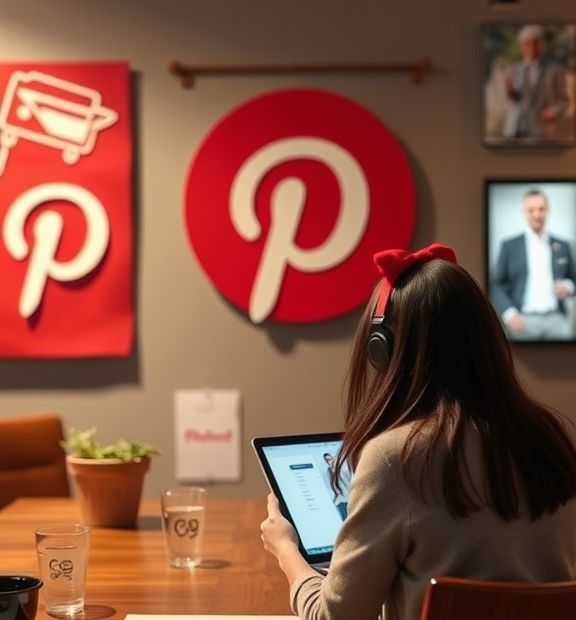Does Pinterest Have Too Many Ads? Exploring User Experience and Engagement
As you scroll through Pinterest, your eye might catch different pins showcasing vibrant DIY projects, delicious recipes, or dream travel destinations. However, it’s hard to ignore the sudden influx of ads populating the feed. Many users have begun to wonder: does Pinterest have too many ads? Let’s dive into this topic and explore how advertising impacts user experience and engagement on the platform.
Initially, Pinterest was a space where creativity thrived and inspiration flowed freely. Users flocked to the site to discover new ideas and save their favorites on categorized boards. However, as the platform has grown, so has the number of advertisements. You might notice that in between personal or creative pins, sponsored content has steadily increased. This shift raises a vital question: are these ads enhancing or detracting from your experience?
The introduction of advertisements on Pinterest was a strategic move to monetize the platform. For businesses, Pinterest offers a unique opportunity to showcase their products to a visually engaged audience. While brands like to promote their offerings, users may feel overwhelmed if they come across too many ads. Here are some points to consider:
- Content Overload: With multiple ads appearing in feeds, users can experience fatigue. If too many sponsored posts disrupt the visual flow, many might disengage from their browsing and pinning activities.
- Relevance Matters: When ads are tailored to a user’s interests, they often enhance the experience rather than detract from it. If the ads promote products or services related to a user’s previous pins, they can provide value. However, irrelevant ads may lead to frustration.
- User Feedback: Pinterest has actively sought user feedback to gauge how ads affect user satisfaction. Listening to its community allows the platform to adjust and curate relevant content, including ads that resonate well with users.
As a user, you may have recently come across sponsored batches of suggestions that closely align with your interests. You might think it’s about balance. If the ads are artistically appealing, informative, and seamlessly blend into your feed, they might just enhance your experience. However, irritatingly repetitive or irrelevant ads can detract from the joy of using the platform.
Engagement on Pinterest is primarily driven by how aesthetically pleasing and inspiring the content is. If a user feels that ads dilute this core value, they might reconsider their usage of the platform. A common sentiment among users is that too many ads can turn the visual delight of Pinterest into a marketing slog. Here’s where the problem lies:
- Ad Saturation: Users may scroll faster when confronted with numerous ads, which diminishes engagement levels.
- Loss of Authenticity: When users see too many ads, they may perceive the platform less as a creative hub and more as a marketplace.
Finding the right balance in advertising is crucial for Pinterest to maintain its user engagement. A strategy focusing on quality over quantity is ideal. Users should feel as though they’re discovering something new, rather than being interrupted by excessive promotions. Moreover, the ability to customize feeds can play a pivotal role in improving overall user satisfaction. Allowing users to see less of what they don’t want is essential in keeping them engaged.
Moreover, users often crave authenticity in advertising. This means that ads need to resonate with the community’s values and interests. When brands participate authentically in the conversation through engaging content, they’re more likely to gain traction. The challenge for Pinterest lies in ensuring that ads maintain this authenticity while still providing value to users.
Love what I do? Be a hero and help me keep creating awesome content!
Support My Mission Now!Every donation fuels more great stuff – thank you, legend!
Continuous innovation is crucial for platforms like Pinterest. By incorporating features that allow users to filter or customize their experience, they can create a unique environment where ads enhance rather than detract. Encouraging a dialogue between businesses and users can lead to more tailored content, fostering a better user experience overall.
While Pinterest continues its journey into the realm of digital advertising, understanding user sentiment is vital. As you explore your favorite pins, pay attention to how ads impact your browsing experience. Finding a satisfactory balance can preserve the essence of creativity while also providing opportunities for brands to connect with users. Ultimately, the key lies in carefully curating ads that inspire rather than overwhelm users.
The Balance Between Advertising and Creativity on Pinterest: Finding the Sweet Spot
Love what I do? Be a hero and help me keep creating awesome content!
Support My Mission Now!Every donation fuels more great stuff – thank you, legend!
Pinterest has become a go-to platform for people looking to discover new ideas and inspiration across a myriad of subjects. From DIY crafts to home decor, Pinterest serves as a creative haven. But as you scroll through the endless pins, you may wonder: does Pinterest have too many ads? This question opens up a vital discussion about the balance between advertising and creativity on the platform.
Advertising is a necessary part of many free services, and Pinterest is no exception. The platform generates revenue through promoted pins, which are ads designed to blend seamlessly into your pin feed. While ads can disrupt the flow of creativity, they also play a crucial role in supporting the platform’s sustainability. The balance here lies in ensuring that users can still enjoy their creative exploration without feeling overwhelmed by promotional content.
To understand whether Pinterest has too many ads, let’s consider a few vital points:
- User Experience: A key factor in assessing Pinterest’s ad balance is user experience. When ads become too frequent, users may feel frustrated and disengaged. If you’re hunting for inspiration but consistently encounter ads, it could deter you from returning to the platform.
- Relevance of Ads: The effectiveness of advertising on Pinterest often hinges on ad relevance. When promoted pins align with your interests, they enhance your experience rather than detract from it. Pinterest’s algorithm aims to show you ads that resonate with your tastes, which can make the experience less intrusive.
- Creativity vs. Promotion: Every pin you encounter should ideally inspire creativity. If promotional content overshadows user-generated pins, it can dilute the creative essence that makes Pinterest special. A thoughtful balance ensures that artists, creators, and everyday users maintain visibility alongside advertisers.
Love what I do? Be a hero and help me keep creating awesome content!
Support My Mission Now!Every donation fuels more great stuff – thank you, legend!
Managing advertisements effectively is not just for profit; it’s vital for maintaining a vibrant community for users. Pinterest has to ask itself: how can it effectively monetize while still keeping users engaged and inspired?
The creative potential on Pinterest is immense. Users flock here to explore ideas that spark imagination, whether through tutorials, design inspirations, or craft projects. Too many ads can disrupt this creative flow. If you’re constantly bombarded with ads, the very essence of Pinterest—creativity—can be lost. It becomes less a place of inspiration and more a marketplace.
Love what I do? Be a hero and help me keep creating awesome content!
Support My Mission Now!Every donation fuels more great stuff – thank you, legend!
As a user, you may have noticed that Pinterest’s ad strategy has evolved over the years. Initially, ads were rarer, but as the platform sought to grow revenue, the number of ads increased. However, recent enhancements in targeting have improved the relevance of the ads appearing in your feed. Here are some strategies Pinterest employs to tailor ads:
- Audience Targeting: Advertisers can reach specific demographics based on user behavior and interests, ensuring the ads presented are likely to be relevant.
- Engaging Formats: Pinterest uses various ad formats, such as video and carousel ads, to deliver ads that can capture attention more effectively than static images.
- Feedback Loop: Pinterest allows users to hide ads they are not interested in. This feedback helps refine its advertising strategy, tailoring it further to user preferences.
Ultimately, the effective balance between advertising and creativity lies in Pinterest’s ability to fine-tune its ad strategy. High-quality, relevant ads can coexist with user-generated content, enhancing rather than disturbing the creative process. To keep users engaged, Pinterest must provide a pleasing equilibrium—one that keeps ads relevant while not overshadowing the creativity that draws users in.
As you interact with the platform, reflecting on your experiences can help. Do you find the ads relevant and beneficial? Or do they detract from the creative experience you seek? Engaging with these questions can influence how Pinterest continues to evolve, balancing the need for revenue with the necessity of creativity. You have a voice in this dynamic ecosystem. By sharing your experiences and feedback, you contribute to shaping the balance of advertising and creativity on Pinterest.
While Pinterest has introduced more advertising over time, the key to its success lies in how it manages to blend creativity and promotion. Finding that sweet spot will ensure that Pinterest remains a platform where inspiration thrives.
Conclusion
As social media continues to evolve, platforms like Pinterest are navigating the delicate balance between user experience and revenue generation. The question of whether Pinterest has too many ads is a nuanced one. On one hand, advertising can enhance the user experience by showcasing relevant products and ideas. For those looking for inspiration, these ads can act as a source of creativity, leading users toward new trends and potential purchases. However, excessive ads can detract from the discovery aspect that initially draws users to Pinterest.
Finding the right equilibrium is crucial for Pinterest. While ads can help brands connect with their target audiences, an overload can overshadow the organic content. It’s essential for the platform to ensure that users still feel they can explore authentic ideas and inspirations without being overwhelmed by promotional content. Encouraging advertisers to create visually appealing, relevant ads can aid in maintaining this balance. This not only enhances user engagement but also creates a more enjoyable experience overall.
Ultimately, the discussion about Pinterest’s ads boils down to the platform’s ability to bring users meaningful content without interrupting their creative flow. By prioritizing engaging, targeted advertising strategies, Pinterest can foster not only a vibrant community but also an effective marketplace for brands seeking to share their products. As the platform continues to grow, its success will hinge on its dedication to listening to user feedback and adjusting its strategies accordingly.

